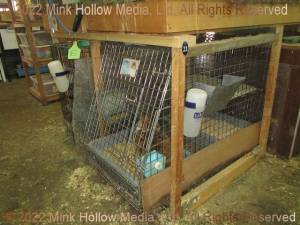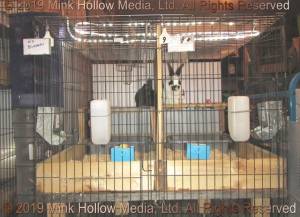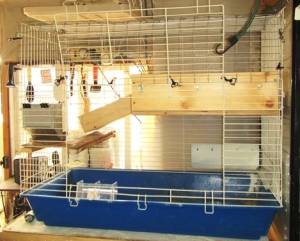This page shows some of my rabbit housing, both old and new.
 Rabbits can be very territorial so it is not always possible to have them share cages or pens. Sometimes it is possible to keep rabbits in a colony setting (that's a large space where multiple rabbits live), but this usually only works with does or immature juniors, and then only if they all go in the space at the same time. Introducing a new rabbit to an established 'colony' usually results in fighting. Many who use colony housing use it only when the does are 'dry' (i.e. not having babies). Sometimes does will raise litters in a colony setting, but there is a danger that other does may injure or even kill babies that aren't theirs. I suspect this is because the environment we have set up does not provide the kind of space that they need to be able to raise litters while still meeting their territorial requirements.
Rabbits can be very territorial so it is not always possible to have them share cages or pens. Sometimes it is possible to keep rabbits in a colony setting (that's a large space where multiple rabbits live), but this usually only works with does or immature juniors, and then only if they all go in the space at the same time. Introducing a new rabbit to an established 'colony' usually results in fighting. Many who use colony housing use it only when the does are 'dry' (i.e. not having babies). Sometimes does will raise litters in a colony setting, but there is a danger that other does may injure or even kill babies that aren't theirs. I suspect this is because the environment we have set up does not provide the kind of space that they need to be able to raise litters while still meeting their territorial requirements.
Bucks can rarely be kept together as they almost always fight. We even have to make sure there is space between each buck's cage wires or they will fight through the fences.
Rabbits are still social animals though, so I always make sure they can see other rabbits from their cages and pens. This is true both inside and out. Outside, the hutches are arranged in a U-shape. The boys are all along one side. No matter where they are, they can always see at least a few other hutches.
Inside Cages
I have a number of different inside cages that get used in different ways.
I try to give my rabbits as much space as possible. If they are going to spend their lives in these cages, they should be comfortable, and have things to do so as not to get bored. They have things to chew and things to play with and most have shelves, which increases the square footage and also adds a bit of choice.
Happy rabbits are healthy rabbits!
Many of my cages have shelves and platforms which increases the square footage.
Here you can see the different cages I have:
X-SMALL (under 5 ft.)
 This one is for temporary use only (16“ x 24” x 15“ high = ~ 2.5 sq. ft). This one is for temporary use only (16“ x 24” x 15“ high = ~ 2.5 sq. ft). It is too small for a standard size rabbit to live in (although it would be Okay for a dwarf breed). My smallest inside cages are used for temporary housing (a few hours or days). |
 This one has just under 5 sq. ft. (32” x 22“ x 18” high). This one has just under 5 sq. ft. (32” x 22“ x 18” high).As you can see there is a shelf to sit on that provides extra space and interest. The rabbit in the picture is Bo, who is retired. He's very laid back and gets to run around the whole rabbitry when I'm doing chores. Mostly what he likes to do is find some nice hay to munch and then sit and watch me work  |
SMALL (5.5 - 7 sq.ft.)
 This is a 40“ x 20” x 20“ high pet rabbit cage (5.5 sq. ft.). This is a 40“ x 20” x 20“ high pet rabbit cage (5.5 sq. ft.). We used to use these for juniors and retired rabbits. Since 2020, we only use them for temporary housing.
If you use a cage like this for your bunnies (pet or otherwise) always be very careful when getting the bunnies out or putting them back in as they can get their feet caught in-between the wires and get hurt. |
 The cages in this one are 30” wide, 24“ deep, and 18” high (5 sq. ft.). The cages in this one are 30” wide, 24“ deep, and 18” high (5 sq. ft.). This is a standard “three-hole stacker”. They are too small for my liking as permanent living spaces for my adult rabbits (although they are fine for smaller breeds). |
 These are 2 small cages that I got in 2019. These are 2 small cages that I got in 2019.They are too small for my adult rabbits (although they are fine for smaller breeds). These cages are 30“ wide, 24” deep, and 22“ high (5 sq. ft.). In case you're wondering, that white shelf was a shoe shelf in a previous life. They increase the 'floor space' to about 7'. Turns out, the bunnies love sitting on and under it (I like it because it's easy to clean). I've anchored it to the side using some shower curtain rings to keep the bunnies from moving it around (see this page for more on them). I use these for pre-juniors (kits that have just been weaned and are still under 4 mo. old) and for temporary housing when needed. The height sets them apart from my other small stackers (they are singles rather than triple units so they are lighter). Thank you Snoozer's Cages for these! |
MEDIUM (7 - 8 sq.ft.)
I use the medium sized cages for juniors, bucks, and open does (does without litters).
Most of my medium sized cages are 30”x36“ all-wire stackers.
They all get resting boards so they can choose whether to sit on the wire or not.
Most have some sort of shelf. Some buns insist on turning all shelves upside down. They just get resting boards.
Most of them also get litter pans. Most use them as actual litter pans, but a few seem to like using them as places to sit and snooze. Occasionally, a rabbit will toss the bin around, or just chew it up, or turn it upside down and use the top as a bathroom. The chewers and ones who insist on turning their pans upside down don't get to have one.
  These are my regular stackers. They are 36” wide, 30“ deep, and 18” high (7.5 sq. ft.). The boys live in the bottom holes (some boys like to spray, so the bottom holes also have dividers between the cages). These are my regular stackers. They are 36” wide, 30“ deep, and 18” high (7.5 sq. ft.). The boys live in the bottom holes (some boys like to spray, so the bottom holes also have dividers between the cages).I use these for everything except does with older litters (> 5 or 6 weeks, depending on how many were in the litter). I also have lighting above each hole so I can see the rabbits easily. |
I also have a few re-purposed cages in the Medium category.
 This is a re-purposed large dog cage. It is 36“ x 22” x 33“ high (5.5 sq. ft.). This is a re-purposed large dog cage. It is 36“ x 22” x 33“ high (5.5 sq. ft.). I use this for anything but does with litters, but mostly they are used for juniors and bucks. This has a shelf too. The shelf adds nearly 2 sq.ft. of 'floor' space, which is why it is in my Medium category. Although these are smaller than my 36” x 30“ stackers, I actually like them a lot because they are high enough that the buns can sit up on their haunches (I've decided that is actually an important rabbit behaviour, so whenever possible, cages should be high enough to let them do that.) |
  This is also a re-purposed large dog cage. It is 35” x 22“ x 32” high (5.3 sq. ft.). This is also a re-purposed large dog cage. It is 35” x 22“ x 32” high (5.3 sq. ft.). I use this for anything but does with litters, but mostly they are used for juniors and bucks. This has a shelf too, AND it is also high enough for the buns to sit up on their haunches. Because of the shelf, this one is also classified as Medium. |
LARGE ( 8 - 10 sq.ft.)
 This ready-made cage falls in my Large category. It is almost 2'x4', but it has the advantage of being nearly 24“ high. The addition of the shelf puts it in the 10 sq.ft. range. This cage is for does with litters.
This ready-made cage falls in my Large category. It is almost 2'x4', but it has the advantage of being nearly 24“ high. The addition of the shelf puts it in the 10 sq.ft. range. This cage is for does with litters.

 This cage is one of my few remaining “floor” cages. It is made entirely of 14”x14“ black wire cage panels. It is 2 panels deep (28”), 3 panels wide (42“), and 2 panels high (28”). The original floor space is just over 8 sq.ft. I have installed 2 triangular shelves in the back corners which adds about 3 extra sq.ft. for a total of 11+.
This cage is one of my few remaining “floor” cages. It is made entirely of 14”x14“ black wire cage panels. It is 2 panels deep (28”), 3 panels wide (42“), and 2 panels high (28”). The original floor space is just over 8 sq.ft. I have installed 2 triangular shelves in the back corners which adds about 3 extra sq.ft. for a total of 11+.
I have noticed that kits can sometimes get their heads stuck in the 1.5“x1.5” openings of the panels for the first few weeks after coming out of the nest, so I have added wire, or other barriers along the bottom and the lower part of the upper shelves.
 Many of my large cages are made using dog ex-pen panels, or a combination of those and small animal cage panels. These cages are all 2' wide and 4' deep (= 8 sq. ft.) with a platform shelf that adds at least 2 sq.ft.
Many of my large cages are made using dog ex-pen panels, or a combination of those and small animal cage panels. These cages are all 2' wide and 4' deep (= 8 sq. ft.) with a platform shelf that adds at least 2 sq.ft.
They are good enough for anyone - including does getting ready to wean litters.
UPDATE: All of my Ex-pens were rebuilt in 2018 to raise them off the ground.
The ones that were 4'high are now 3'high but a foot off the ground, making them MUCH easier to clean (my knees aren't what they used to be.)
The bottoms are plywood, framed by 1×6 boards.
The inner part of the base is painted to keep it drier and make cleaning easier. It gets re-painted once a year, or whenever a new rabbit moves in.
The shelf at the back is about 18“deep which makes the platform 3 sq ft, for a total of 11 sq ft of living space.

 These are cages I designed and built in 2018.
These are cages I designed and built in 2018.
I got a deal on some 24” high dog expens.
I built a base out of 2'x4'x1/2“ plywood, framed with 1×6 boards.
I took off 2 of the expen panels and used them for the top, and attached the remaining 6 panels to the base.
They are heavy, but very sturdy and give the rabbits a fair bit of room (8 sq. feet). The pieces are all attached with screws.
It's more expensive than nails, but WAY easier on my joints (no hammering), AND I can replace pieces if/when I need to fairly easily (like if they become too chewed).
Again, I really like the height. The buns seem to too.
UPDATE: I added a shelf (with “railing”) along the back in 2019.
This adds approximately 3 more sq.ft. for a total of nearly 11 sq.ft. of living space.

 Also in my Large category are a pair of attached cages that I built in 2020 using some scrap wood and wire cube shelf panels that I came into. The cages are just under 2' wide and 45” deep. That makes them under 8 sq.ft. but they have an “upper level” that adds about 3 sq.ft. for nearly 11 sq.ft.
Also in my Large category are a pair of attached cages that I built in 2020 using some scrap wood and wire cube shelf panels that I came into. The cages are just under 2' wide and 45” deep. That makes them under 8 sq.ft. but they have an “upper level” that adds about 3 sq.ft. for nearly 11 sq.ft.
These cages are for bucks.

 For this rebuild (2020), I used two 22“x44” ready-made cages and turned it into one that is twice as high. I added an upper level that has a railing all around except for the ramp. It also has a second middle shelf.
For this rebuild (2020), I used two 22“x44” ready-made cages and turned it into one that is twice as high. I added an upper level that has a railing all around except for the ramp. It also has a second middle shelf.
The original cage is about 6.5 Sq.ft. The extra level about 4' more for a total of 10.5 sq.ft.
What I have noticed with all of the multi-level cages is that the rabbits really LOVE relaxing on the shelves.
When it comes to does with litters, the does have a place to get away from their kits once the kits start venturing out of the nest box - at least, until the kits get big enough to jump up.
The does do seem to appreciate the ability to get away from their kits.
X-LARGE ( >10 sq.ft.)

 In 2018 I rebuilt all of the old cages I had originally made out of ex-pens.
In 2018 I rebuilt all of the old cages I had originally made out of ex-pens.
The 3'high expens have been turned into 2 stackers and a single.
The top cage of the stacker is still 3' high, as is the single.
They now have 2 shelves with a ramp that leads up to the second shelf.
There is a “railing” along the ramp and the top shelf to cut down on accidents.
The buns really seem to love being on the top shelf, and the babies, once they are big enough, have great fun running up the ramp and sliding down!
There are also extra wire panels attached because the babies can squeeze through the ex-pen bars when thy first start running around.
The taller ones cages are 2'x4' but have shelf space that adds 4-5 extra sq.ft. so these are 12 sq.ft. or more.
The shorter ones still have at least 2 extra sq.ft. of shelf space so they are also over 10 sq.ft.
This gives plenty of space for a doe with a litter.

 My 2021 build uses 14“x14” black wire cage panels (that can be purchased as build it yourself rabbit cages), and some IKEA shelving.
My 2021 build uses 14“x14” black wire cage panels (that can be purchased as build it yourself rabbit cages), and some IKEA shelving.
It was IVAR shelving that I doubled so that instead of being 12“ deep, it is 24” deep. With a double length of shelf, the cage is 5 1/2' long. The original shelves are 33“x12”. I had enough shelving to also include a full width upper shelf in one half.
The floor space for each cage is just over 11 sq.ft., and the upper shelf adds another 5.5 for a total of 16.5 sq.ft. On one half, they are 30“ high.
The image on the left is of the cage before it was finished, and the one on the right is all done and ready for occupancy.
I'm using these for does with litters. The feeders are on the second shelf to encourage the doe to get exercise. I'll put a dish on the lower level for the kits until they can jump up as well.

 These are my biggest indoor pens.
These are my biggest indoor pens.
They're made from a single dog ex-pen. They're 4' x 4' (= 16 sq. ft.)
They also have at least one shelf, and a tree stump).
I use these for retirees, and for groups of youngsters before they “graduate” to individual cages.